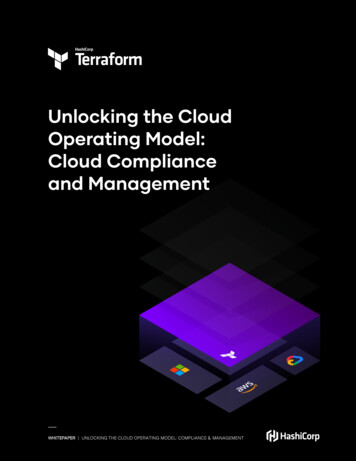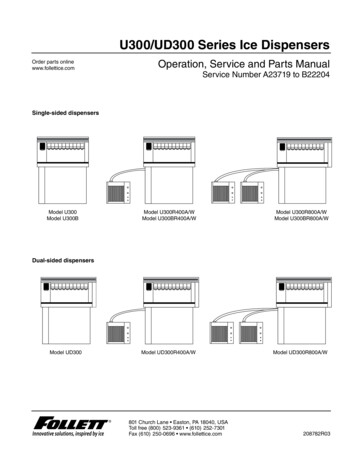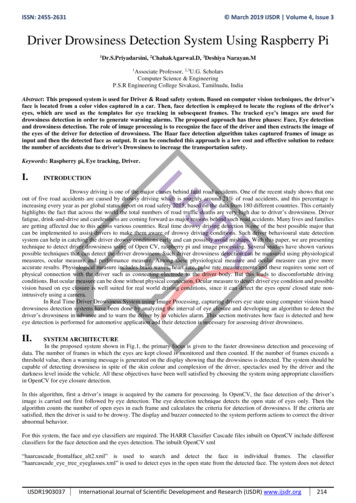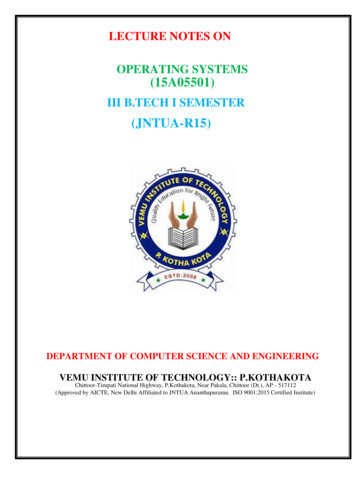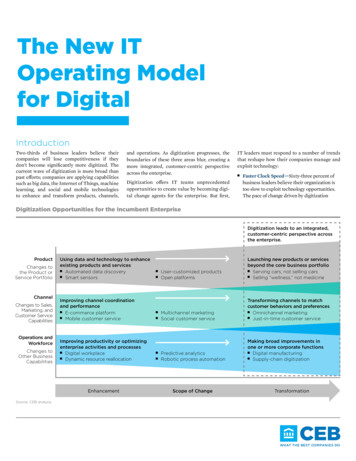
Transcription
The New ITOperating Modelfor DigitalIntroductionTwo-thirds of business leaders believe theircompanies will lose competitiveness if theydon’t become significantly more digitized. Thecurrent wave of digitization is more broad thanpast efforts; companies are applying capabilitiessuch as big data, the Internet of Things, machinelearning, and social and mobile technologiesto enhance and transform products, channels,and operations. As digitization progresses, theboundaries of these three areas blur, creating amore integrated, customer-centric perspectiveacross the enterprise.Digitization offers IT teams unprecedentedopportunities to create value by becoming digital change agents for the enterprise. But first,IT leaders must respond to a number of trendsthat reshape how their companies manage andexploit technology: Faster Clock Speed—Sixty-three percent ofbusiness leaders believe their organization istoo slow to exploit technology opportunities.The pace of change driven by digitizationDigitization Opportunities for the Incumbent EnterpriseDigitization leads to an integrated,customer-centric perspective acrossthe enterprise.ProductChanges tothe Product orService PortfolioChannelChanges to Sales,Marketing, andCustomer ServiceCapabilitiesOperations andWorkforceChanges toOther BusinessCapabilitiesUsing data and technology to enhanceexisting products and services Automated data discovery Smart sensorsImproving channel coordinationand performance E-commerce platform Mobile customer serviceImproving productivity or optimizingenterprise activities and processes Digital workplace Dynamic resource reallocationEnhancementSource: CEB analysis. User-customized productsOpen platformsLaunching new products or servicesbeyond the core business portfolio Serving cars, not selling cars Selling “wellness,” not medicineMultichannel marketingSocial customer serviceTransforming channels to matchcustomer behaviors and preferences Omnichannel marketing Just-in-time customer servicePredictive analyticsRobotic process automationMaking broad improvements inone or more corporate functions Digital manufacturing Supply-chain digitizationScope of ChangeTransformation
will only increase as new generations of fastmoving competitors emerge and customerscome to expect ever more rapid updates toproducts and services enabled by technology. Heightened Volatility—Digitizationopportunities quickly rise and fall, so businessplans are constantly in flux. Companies areswitching from multiyear technology planningand road-mapping to relying on the conceptsof “test and learn” and minimum viableproduct.Blurred Technology Responsibility—ITleaders used to insist there were no technologyprojects, only business projects. Today theopposite is becoming true as almost allbusiness projects become technology projects.As a result, business strategy and IT strategyare becoming synonymous, and businessleaders are more willing and able to moveforward with digital initiatives by themselves.To meet these challenges head on, progressiveIT leaders are making IT more adaptive. Anadaptive IT organization accelerates the rest ofthe business rather than hindering it, changesdirection as demands change, and flexesbetween different modes of business collaboration based on context.The best way to become adaptive is to changeIT’s operating model. We have identified ninefeatures of the new operating model that willposition IT teams for digital success.Key Features of the IT Operating Model for Digital2Adaptive Business EngagementPMOInfrastructure EngineeringOperations and Support5Applications Building Blocks6Cloud-Based Scalable Infrastructure7Strategy OverGovernance,ManagementOver Operations1 Products Over Projects:Priorities and budgets are setfor business capabilities andproducts, not projects.3 Agile, DevOps, ContinuousDelivery: Integrated delivery,engineering, and support boostresponsiveness and output.6 Cloud-Based ScalableInfrastructure: IT automationand cloud platforms cuts timeto scale.2 Adaptive BusinessEngagement: Businessengagement approach flexesbased on business context.4 Customer-Centric Design:Customer-journey mapping isused to guide design.7 Strategy Over Governance,Management Over Operations:Central groups refocus onfacilitating strategy, innovation,change, and enterprise data.5 Applications BuildingBlocks: APIs, platforms, data,and reusable services reduceeffort and accelerate delivery.Source: CEB analysis.2The New IT Operating Model for Digital9Adaptive Skills and Mind-SetAgile, DevOps,ContinuousDeliveryApplications Development8Data Strategy Over Ownership3Products Over ProjectsInformation RiskCustomerCentric DesignEnterprise Architecture148 Data Strategy OverOwnership: Coherent strategyand guidelines around dataallow for rapid exploitation bydistributed teams.9 Adaptive Skills and MindSet: Staff become technicallyversatile, collaborative, and opento innovation.
1. Products Over ProjectsWhat Is It?Traditionally, IT investment is structured as apool of ongoing “run the business” costs and aseparate portfolio of discrete capital projectsthat have a clearly defined beginning and end.But organizations are now beginning to alignfunding, development resources, and ongoingmanagement support around a set of enduring product lines. These product lines—alsoreferred to as “end-to-end IT services,” “platforms,” “experiences,” or “value streams”—arealigned to the organization’s most importantbusiness capabilities, which are the core activities business partners need to accomplish theirobjectives.line. They also oversee the product line’s fulllifecycle, from launch to ongoing performancemanagement to retirement.This shift in IT funding structure doesn’t mean,as many have suggested, that the concept ofdiscrete projects is dead; projects and programswill still support product lines in the digitalfuture. However, it does mean that product linesbecome the primary focus in setting spendingpriorities and allocating IT capital while projects and programs are simply the way in whichthe work gets done.In the new approach, a dedicated product lineor service manager works with all relevantbusiness stakeholders to create a strategic capability and investment roadmap for each productHow Does It Fit with the Rest of theOperating Model?“Products over projects” is at the heart of theoperating model for digital. Product-line managers play an important role in making businessengagement more flexible and adaptive, usingtheir knowledge of business capabilities andstakeholders at multiple levels to translatebusiness need into customer-centric designs.They also prioritize both new developmentand enhancements to product lines deliveredthrough Agile and DevOps approaches, usingapplications building blocks and cloud-basedinfrastructure.Business Capabilities Defined:Why Are IT Organizations Doing This?A structured way of expressingthe activities the enterpriseperforms to achieve its desiredbusiness outcomesOrganizations typically allocate IT budgetsand resources after carefully considering a longline of competing project proposals. However,the resulting investment portfolio frequentlydoesn’t reflect the organization’s priorities asHow Autodesk Aligns IT Resources to Core Business CapabilitiesCIO, IT1Align ITresources tobusiness valuestreams.Plan: RelationshipManagement andPlanningBuild: EnterpriseApplications Delivery2Drive endto-endaccountabilityin developmentand operations.Equip supportwith businessdomainexpertise andauthority.CFOCompensation Value StreamFinancialsValue StreamIT Domain DirectorBusiness AnalystsIT Domain DirectorBusiness AnalystsProject TeamProject TeamDevOps EngineersDesign and develop automated services architecture.Run: Enterpriseand Operations3Chief Sales andService OfficerBusiness-AlignedSupport TeamBusiness-AlignedSupport TeamService ManagerService ManagerTechnical Applications Support StaffPrimarily contractors; conduct work that does not require businessdomain knowledge (e.g., patching)Source: Autodesk, Inc.; CEB analysis.3
scarce funding is spread relatively evenly acrossrequestors. This approach also fractionalizesmoney and staff, leaving them captive to individual projects, and slows the organization’sresponse as priorities change or new demandemerges. By shifting their focus from projects to productlines, organizations achieve the following: Initial funding and resource allocation thatis better aligned to the organization’s mostsignificant sources of value: organizations withproduct-aligned funding see an increase of upto 50% in the proportion of their IT budgetfocused on key business priorities.A role (e.g., product-line manager) thatcontinuously improves the product offeringthrough a deep understanding of businessneeds and a close relationship to the product’susers: this contrasts with traditional servicemanager roles that operated services butweren’t responsible for service innovation.Greater flexibility when business needschange: product-line managers can shiftmoney and resources nearly 90% faster byavoiding extensive negotiation with peers andbetter framing trade-offs between speed, cost,and adoption.Reduced cost for delivering the work in theportfolio: elevating decisions and activities—such as business case creation or theevaluation of scope-change requests—abovethe project level can reduce the effort requiredfrom IT and business partners and save up to 4 million annually.The foundation for a continuous deliverymodel: these changes allow for dedicated,product-line-based delivery teams and thefunding flexibility necessary to conduct Agileat scale.Lessons from PractitionersLeading practitioners use the following strategies to make product-line-based allocation work: 4Define a handful of product lines that alignto the organization’s most critical businesscapabilities. To identify these capabilities, ITleaders can use enterprise and business-unitstrategic plans, senior executives’ performancegoals, and business partner interviews.Business capabilities remain fairly stable yearover year, but their relative importance maychange. Not all business capabilities need to bedefined at once, and many organizations startwith a handful of product lines rather thanattempting a much riskier all-at-once rollout.The New IT Operating Model for Digital Determine the relative importanceof product lines, and allocate fundingproportionally. Weigh the importance ofthe product lines annually by guiding seniorbusiness partners through a structured tradeoff exercise, such as a pair-wise comparison.Then use those weightings to guide initialcapital allocation.Empower the product-line manager. Ratherthan tying reprioritization and reallocationdecisions to an annual or quarterly enterpriselevel process, give product-line managers theautonomy to shift funding and resources whentheir product line’s strategy and investmentroadmap change.Create visibility across product lines.Establish regular coordination among productline managers to spot cross-product-lineopportunities to replicate innovation, avoidduplicative effort, manage interdependencies,and reallocate unused funds.Take Action Allocate IT investment by capability-basedproduct lines. Brocade’s Strategic PillarInvestment Targets (CEB CIO) Align delivery resources to product lines. Autodesk’s Changing the ApplicationsDelivery and Support Model (CEBApplications) Design an empowered product-linemanager role. Service ManagerResponsibilities and Skills (CEB CIO) Identify and visualize interdependencies. Nationwide’s Agile Metrics for CoordinatedDelivery (CEB Applications) Reallocate funding across product lines. State Farm’s Trigger-Based ProgramBudget Scraping (CEB PMO) Put product lines at the heart of yourplanning process. CEB IT RoadmapBuilder (CEB)Note: Access to these resources is available only tomembers of each program. Please contact your CEBaccount manager or e-mail IT.Support@cebglobal.comif you would like to learn more about this content.
2. Adaptive BusinessEngagementWhat Is It?In the digital enterprise, business partners have a wider range of IT needs than istypically accommodated through traditionalbusiness engagement channels (e.g., IT–business relationship managers) and processes (e.g.,requirements development and documentation).Seventy to eighty percent of business partnerswant strategic advice on digital opportunitiesand risks as well as technical advice and supporton digital capabilities—and the ability to accessthe expertise they need at multiple levels.Adaptive business engagement flexes based onbusiness context and need. In this approach,the IT organization shifts between five activities—evangelizing and educating, consulting,brokering, coaching, and delivering—based onbusiness partners’ digital ambition and ability.How Does It Fit with the Rest of theOperating Model?Because no single function or individual canown or master all five of the activities IT mustcover in this approach, business engagementbecomes a part of everyone’s job and skill set.Many of the groups emerging or evolving in thenew operating model—including product-linemanagers, Agile and DevOps teams, teams shifting from operations to management, and teamsshifting from governance to strategy—thereforework directly with business partners throughone or more of the activities. Adaptive businessengagement requires an adaptive mind-set andskills; as a result, talent gaps often slow the transition to this new engagement approach. Why Are IT Organizations Doing This?IT–business collaboration has to evolve tosupport an enterprise-wide digital strategy.Digitization has increased the diversity and digital maturity of business stakeholders who workwith IT, and this diversity has led to a widerrange of activities required from corporate ITdepartments. It has also increased the importance of the time spent advising and consultingbusiness stakeholders trying to work their waythrough a digital project or strategy. Given the range of business capabilities thatcan “go digital,” it’s too much for a central teamor a function like the IT–business relationshipmanager to provide meaningful expertise andsupport. Our survey findings support this conviction; only 21% of business partners feel thatIT provides effective advice.Case in Point: Intel Introduces an AdaptiveDigital Engagement ModelLessons from Practitioners Flex IT’s engagement role. IT’s role inbusiness engagement is context-based, notpreordained. Understand your businessstakeholders’ digital ambition and technicalability to determine the engagement activitiesIT should support (e.g., coaching or consultingas opposed to delivering).Organize around business capabilities.Build business engagement channels aroundwhat business leaders are trying to get donerather than how the company is organized. Thispromotes the right collaboration among diversebusiness stakeholders supporting digital projects.At Intel, each IT service leader designs an IT–business interface team with a specific mix ofbusiness engagement skills and technical expertise. Their design is based on an assessment of thebusiness capability needs supported by that service and the activities required at the interface.For example, for a digital customer-experienceservice, where external parties do much ofthe delivery, the engagement activities neededare consulting on new technology investmentsand coaching on how best to exploit thoseinvestments. To ensure business leaders haveimmediate access to expertise in these areas,the service leader may assemble a collaborative team drawing from enterprise architects,project managers, business analysts, or riskmanagers—an engagement team custom-suitedto the needs of business stakeholders.1 Structure a business engagement modelaround business capabilities, access totechnical expertise, and idea sharing. Intel’s Adaptive Digital Engagement Model(CEB CIO) Understand changes in enterprisedemand for technology skills. The TalentImplications of Digitization (CEB CIO) Develop accelerated self-service tracks forbusiness partner demands. DIRECTV’sAdaptive Delivery Paths (CEB Applications) Assess the preparedness of your businessanalysts and project managers for anadaptive business engagement model. Business Analyst Effectiveness Diagnostic(CEB Applications) and Project ManagerEffectiveness Diagnostic (CEB PMO)Keep abreast of emerging digital trends, and educatebusiness partners on opportunities to create valueEvangelizing from technology.2ConsultingOffer advice and frameworks to enable successfulbusiness leadership of technology investments.3BrokeringProvide the internal and external connections neededfor business leadership of technology investments.4Develop employee skills to help them make full useof the enterprise’s technology and information.5DeliveringOwn the process of delivering technologyfunctionality, or provide integration capabilities forbusiness-led technology investments.Source: CEB analysis.Build technical depth and engagement skills inparallel. A more flexible, team-oriented modelfor business engagement can’t work unlesstraditional engagement roles (e.g., businessanalysts) develop stronger technical knowledgeand delivery teams build relationshipmanagement and influencing skills.Take ActionFive Engagement ActivitiesCoachingAccelerate access to technical expertise.Give business partners access to a wider rangeof expertise in IT. Rather than channelingrequests through a single point of contact suchas an IT-business relationship manager, buildon-demand teams that can provide the mix ofknowledge and engagement activities businessstakeholders require.Flex betweenthe fiveactivities basedon businesspartners’ digitalambition andability, not theirpersonality orways of working.Note: Access to these resources is available only tomembers of each program. Please contact your CEBaccount manager or e-mail IT.Support@cebglobal.comif you would like to learn more about this content.5
3. Agile, DevOps, ContinuousDeliveryadvantage of automation and establish frequentcollaboration between development, infrastructure engineering, and support teams).What Is It?How Does It Fit with the Rest of theOperating Model?To meet digital expectations for responsiveness,output, and “always on” products, corporateIT departments need to integrate delivery,engineering, and support teams. A continuousdelivery approach enables a software deliverymodel in which releases occur as soon as a newfunctionality is ready in the smallest amountthat will independently provide business value.Advanced IT automation allows teams to test asthey go, so code is consistently production readyand can be released with minimal effort andzero downtime.To achieve continuous delivery, organizationsare marrying “Agile at scale” (i.e., iterativesoftware development methods) with DevOps(i.e., team structures and workflows that takeAgile and DevOps are essential to ensuring alignment across delivery and supportfunctions as product lines work against aset of customer-centric business objectives.Moreover, a shift toward Agile and DevOpsdelivery models allows IT to take advantage ofthe speed and flexibility offered by applicationsbuilding blocks and cloud-based infrastructuretechnologies.Why Are IT Organizations Doing This?Digital products and services are distinguishedfrom conventional products or IT projects bythree primary characteristics:1. Their success is heavily dependent on speedto market because customers have lowswitching costs between products or servicesthat can be rapidly replicated. In the digitalmarket, business leaders cannot afford delaysdue to internal handoffs between the delivery, engineering, and support functions; allof these functions must have a unified viewof customer outcomes to guide prioritizationand effort.2. Their success is dependent on scaleacross customer contexts and platforms.Development teams in the digital enterpriseneed to collaborate with engineering teams tocode for infrastructure and ensure effectiveperformance at scale.3. Their success is more dependent on supportbecause run-time failure in the product orservice can lead to revenue and customer loss.Support requirements must therefore be integrated early in the design phase of development.Roadmap for Identifying the Key Steps and Timeline in a DevOps Initiative and DevOpsInitiate YourDevOpsJourneyBuild the Business CaseDefine ObjectivesManageChange Acrossthe EnterpriseRedesign ITCoordination ProcessesAddress Security and Compliance ConcernsInstill a DevOps CultureDefine DevOps RolesResourceDevOpsManage theDevOpsTool ChainMonitor andImproveDevOpsSource: CEB analysis.6The New IT Operating Model for DigitalDesign and Adjust Team StructuresCreate an AutomationStrategyRationalize the Tool ChainIdentify TopAutomation OpportunitiesCreate a DevOpsRelease DashboardExchange DevOps Learningsand Best Practices
By integrating delivery and support functions,continuous delivery allows IT teams to meetexpectations for faster speed to market andspeed to scale and to provide seamless supportfor new functionality.Lessons from Practitioners Make coordination between Agile teamsand the rest of IT a design principle, notan afterthought. Too often, IT grows itsAgile development efforts in “stealth mode”without coordination between engineering,support, and IT governance functions. Asa result, it quickly loses speed-to-marketadvantages.Build continuous delivery workflowsand the product-aligned organization inparallel. Continuous delivery models basedon Agile and DevOps principles cannot scalewithout a structure that supports dynamicresource allocation.Design the delivery model to fit businesscontext, not methodology. Corporate ITdepartments might define their approachto Agile and DevOps based on jargon-ladenframeworks that raise change managementrisks and confuse business stakeholders.Smarter approaches start with a clear sense ofbusiness objectives and constraints and adopta selective, incremental approach to the Agileand DevOps practices they implement.Focus first on change management.Movement toward a continuous deliverymodel challenges the ingrained culture ofcorporate development and infrastructureteams. Leaders should emphasize changemanagement approaches that focuson experimentation, promote organicparticipation and feedback across IT, andemphasize the problems to be solved ratherthan the method.Case in Point: Autodesk Changes theApplications and Delivery Support ModelAt Autodesk, the shift from “boxed” softwareto subscription-based digital products and services has transformed the delivery and supportmodel to focus on zero-downtime deployments,automated testing, and end-to-end accountability for product outcomes. DevOps at Autodeskemphasizes collaboration and communicationbetween Agile development teams and operations while automating the software deliveryprocess and infrastructure changes.In this model, DevOps engineers and support managers focus on enabling teams toself-support and self-provision across development stages. Using DevOps, Autodesk’s ITteam incorporates support expertise aroundnonfunctional requirements early in the designlifecycle and ensures that new releases (definedin terms of “minimum releasable units”) areassessed from perspectives of both developmentand operations quality.Take Action Structure continuous delivery in aproduct-aligned organization. Autodesk’sChanging the Applications Delivery andSupport Model (CEB Applications) Plan the rollout of a DevOps model. DevOpsImplementation Roadmap (CEB Applications) Benchmark the effectiveness of your Agileteams. Agile Improvement Diagnostic(CEB Applications) Develop a change-management programto support continuous delivery. MolinaHealthcare’s Managing Change inEngineering Practices (CEB Infrastructure)Note: Access to these resources is available only tomembers of each program. Please contact your CEBaccount manager or e-mail IT.Support@cebglobal.comif you would like to learn more about this content.7
4. Customer-Centric DesignWhat Is It?Customer-centric design ensures technology,processes, and information are structured tominimize customer effort in interacting witha company. Customer-centric design encompasses all the techniques needed to:1. Understand customers’ experiences,2. Determine the root causes of unnecessaryeffort or friction in those experiences, and3. Use that information to design a better, easierexperience.Importantly, these techniques are notnecessarily limited to digital channels or technology-enabled products; they can be applied toany part of the customer experience.How Does It Fit with the Rest of theOperating Model?Customer-centric design is often used by product lines to ensure products meet user needsand the low-effort threshold required for effective adoption. Agile teams, with their focus onminimal viable product, typically emphasizedevelopment that satisfies “user stories” ratherthan the proliferation of unnecessary featuresand complexity. Customer-centric design is oneof several strategic roles enterprise architectsmay take on as they shift their time away fromlower-value governance activities.The Difference Between UserExperience and CustomerExperienceUser experience is a subset ofcustomer experience that focuseson visual design, interactiondesign, and technology usability.Customer experienceencompasses customer service,the sales process, how a productis delivered, and how productproblems are resolved, in additionto the user experience.While IT functions have thoughtabout user experience for years,thinking about the broadercustomer experience outside ofthe elements of user experience isa newer activity for many IT staff.While many companies already have customerexperience teams, corporate IT teams (andparticularly enterprise architects) have a numberof capabilities to contribute to customer-experience improvements, including: Understanding of enterprise systems, Cross-enterprise perspective, The ability to manage near-term and long-termpriorities in parallel.Lessons from Practitioners Why Are IT Organizations Doing This?Our analysis of the customer experience shows thatreduced customer effort is the single most important factor in determining whether a customer willspend money with a company again. Technologyhas become essential to creating a low-effort customer experience as more companies reach limitsin their ability to improve the customer experiencethrough changes to people or processes.Insight into the relationship betweentechnology and business strategy, and Identify where IT should get involved. ITshouldn’t try to get involved in every part ofcustomer-experience improvement, even inorganizations without a dedicated corporatecustomer-experience team. Instead, ITleaders should carefully triage their teams’involvement based on where their crossenterprise perspective and familiarity withdata and systems are most applicable.Look at customer experience acrossbusiness silos. Many customer-experienceproblems arise at the handoff between acompany’s products, teams, or technologysystems. Corporate IT can often see acrossthese silos in ways other teams cannot.Customer-Journey Map for Making Changes to a PolicyJourneyPhasesIssue ArisesCustomerTouchpointsVisitFAQsPolicy ChangeContactState FarmSubmitChangeResolutionFollow up ionshipManagementBusiness capabilities map to underlyingdata and systems, allowing EA to identifythe root cause of a customer’s pain point.Source: State Farm; CEB analysis.8ManageRelationshipOperationalSupportThe New IT Operating Model for DigitalManageUnscheduledChangesBusiness capability health fromthe perspective of the customer?CustomerProfileManagementPotentially missingcapabilities
Tie technology plans to the customerjourney. Corporate IT is best positionedto connect each step of the customerjourney to the supporting technologies. IfIT investments are clearly tied to steps in acustomer journey, prioritizing and securingfunding will likely be easier.Use real customers to change IT’s thinkingabout customer experience. Thinkingabout the customer experience in abstractrarely changes the way IT staff approachtheir work. Instead, embed discussionsabout real customers (or customer personas)into project reviews and other steps in thedevelopment process.capture which processes, systems, technologies,and teams support each capability, State FarmEA could quickly diagnose the root cause ofpoor customer experience. By doing this, StateFarm could quickly and accurately prioritizefixes to suboptimal customer experiences.Take Action Map customer journey maps to businesscapabilities. State Farm’s Applying aCustomer-Experience Lens to IT Planning(CEB Architecture) Use customer personas to change how ITstaff think about customer experience. Consider the Customer Experience(CEB Architecture) Learn about the importance of reducingcustomer effort. About the EffortlessExperience (CEB) Plan the rollout of a DevOps model. DevOps Implementation Roadmap(CEB Applications)Case in Point: State Farm Applies aCustomer-Experience Lens to IT PlanningState Farm, a large insurance company, knewthat customers who owned many of its insurance products sometimes had trouble applyingchanges to all the products they owned. Inresponse, the enterprise architecture (EA)team and corporate customer-experience team(which is not part of IT) cocreated four customer-journey maps. Each customer-journey mapoutlines all the steps a customer goes through toaccomplish one of four common tasks (such asbuying or changing a policy).Note: Access to these resources is available only tomembers of each program. Please contact your CEBaccount manager or e-mail IT.Support@cebglobal.comif you would like to learn more about this content.State Farm’s EA team linked the customerjourne
Delivery (CEB Applications) Reallocate funding across product lines. State Farm's Trigger-Based Program Budget Scraping (CEB PMO) Put product lines at the heart of your planning process. CEB IT Roadmap Builder (CEB) Note: Access to these resources is available only to members of each program. Please contact your CEB




